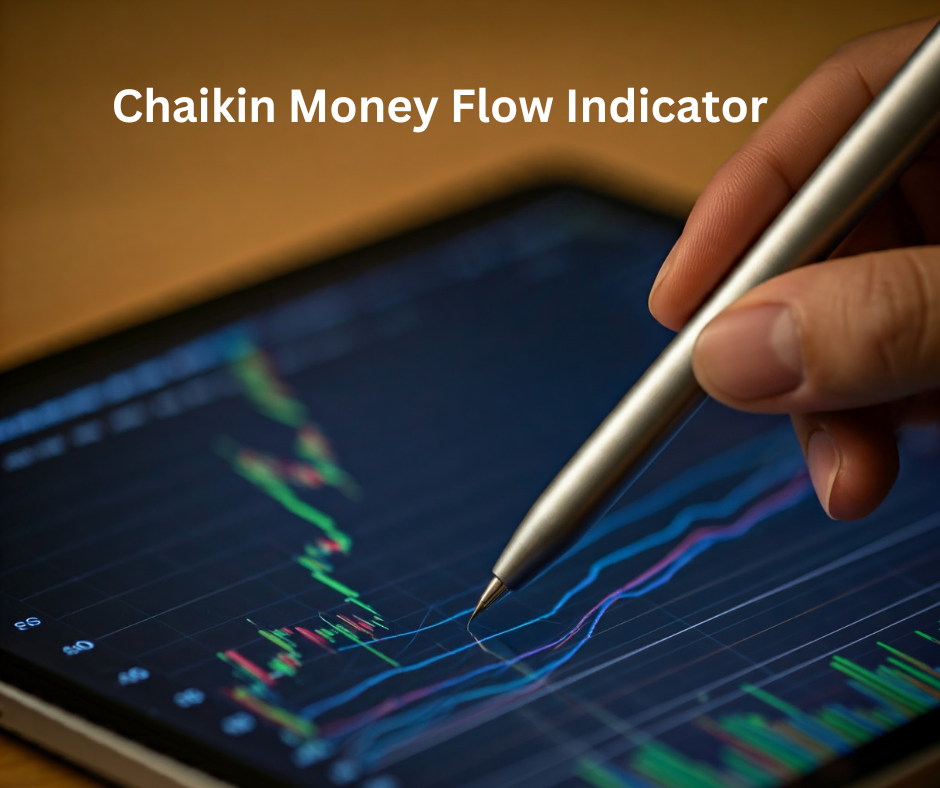Chaikin Money Flow Indicator
Chaikin Money Flow Indicator: A Detailed Guide for Futures Trading
The Chaikin Money Flow (CMF) indicator is a valuable technical analysis tool used by traders to measure the buying and selling pressure on a financial asset, based on volume and price movements over a specific period. Created by Marc Chaikin, this volume-weighted indicator provides insights into market momentum, helping traders make informed decisions by identifying trends and potential reversals. In this article, we’ll cover the fundamentals of the Chaikin Money Flow indicator, break down the formula, and discuss how futures traders can apply it to their strategies.
Overview of the Chaikin Money Flow Indicator
The Chaikin Money Flow indicator helps traders determine whether a market is in an accumulation (buying) or distribution (selling) phase. CMF assesses this by examining the relationship between price movement and trading volume. For futures traders, who frequently analyze price and volume changes to understand the market’s sentiment, this indicator can be a reliable tool to identify entry and exit points.
The Chaikin Money Flow Formula
The CMF calculation relies on three main components:
- Money Flow Multiplier: A calculation that evaluates the buying or selling pressure based on how the current price closes relative to its high-low range for the day.
- Money Flow Volume: A metric that combines the money flow multiplier and trading volume to produce a value representing money flow over a specific period.
- Chaikin Money Flow (CMF): The final value, which is the sum of money flow volumes over a set period, typically 20 or 21 days.
The CMF Formula Explained
- Calculating Chaikin Money Flow
- The value of Chaikin Money Flow is calculated in the following three steps:
- Money flow multiplier
The first step is to determine each period’s money flow multiplier as follows: - Money Flow Multiplier = ((Close value – Low value) – (High value – Close value)) / (High value – Low value)
- Money flow volume
The next step is to calculate the volume of money flow by multiplying the volume for the period by the money flow multiplier obtained in step one. It is usually calculated on a daily basis but can be figured otherwise, such as hourly or weekly. - Money Flow Volume = Money Flow Multiplier x Volume for the Period
- CMF
The last step is to calculate the CMF value. Simply divide the daily money flow over a certain period of time by the sum of volume for the same period. The default number of periods for CMF is 21 days, as this represents the trading over the past month. (There are typically 21 or 22 trading days in each month.) The formula is as follows: - CMF = 21-day Average of the Daily Money Flow / 21-day Average of the Volume
How the CMF Indicator Works in Futures Trading
In futures trading, CMF can help identify if a contract is being accumulated or distributed by the market. Here’s how to interpret CMF values:
- Positive CMF Values (>0): Indicate that the asset has strong buying pressure. For futures traders, a sustained positive CMF value could signal a bullish sentiment, suggesting the possibility of an upward trend in the near term.
- Negative CMF Values (<0): Reflect selling pressure. A negative CMF suggests that traders are likely distributing the asset, pointing towards a potential downward trend.
Applying CMF to Futures Trading Strategies
The Chaikin Money Flow indicator is valuable for futures traders who use volume data to confirm price action trends. Here are a few ways to integrate CMF into futures trading strategies:
1. Trend Confirmation
A primary use of CMF is confirming trends. When the price of a futures contract is moving in a certain direction, a corresponding CMF value helps confirm if that move is supported by volume. For instance, if a futures contract on crude oil shows an upward trend in price, a positive CMF indicates strong buying interest, confirming the strength of the trend.
In futures trading, this can be especially useful for validating a trend during volatile market conditions. When combined with other trend indicators like Moving Averages, the CMF can give futures traders the confidence to hold positions or add to an existing position in the trend’s direction.
2. Identifying Reversals
CMF can also help identify potential reversals in price trends. Futures markets often experience sharp price movements, making it crucial for traders to spot possible turning points early.
A common reversal signal in CMF occurs when there’s a divergence between CMF and price:
- Bullish Divergence: When the price of a futures contract is making new lows, but the CMF is rising, it could indicate weakening selling pressure and the potential for a reversal to the upside.
- Bearish Divergence: Conversely, if the price is making new highs while the CMF is declining, this may signal waning buying pressure and a potential reversal to the downside.
3. Spotting Entry and Exit Points
In addition to confirming trends and reversals, CMF can help traders pinpoint entry and exit points. Here’s how:
- Long Entry: When the CMF rises above zero, it can indicate a buying opportunity, especially if it coincides with other bullish indicators, such as a trendline breakout. Futures traders could take this as a cue to enter long positions.
- Short Entry: When the CMF dips below zero, this signals selling pressure, which could be used to justify a short position, especially if price action also points to a downtrend.
4. Bull Bear Flag Scalps – the Chaikin Money Flow indicator helps identify whether buying or selling pressure supports the price action. This is essential on lower time frames, where market noise can make it challenging to determine genuine setups from false signals.
The CMF indicator helps filter out weaker setups, ensuring that only entries with significant buying or selling interest are considered. By using this indicator with bull and bear flag patterns, traders can find high-probability trades and avoid uncertain price movements.
Long Entry with Bull Flag Setup
When a bull flag forms, we look for a positive CMF reading to confirm buying pressure before entering a long trade. The positive CMF value indicates that the asset is being accumulated, supporting the likelihood of an upward continuation. This helps eliminate entries where the buying interest is weak or absent.
Short Entry with Bear Flag Setup
When a bear flag pattern appears, we seek a negative CMF reading to validate the selling pressure before entering a short trade. A negative CMF suggests distribution, increasing the probability of a downward continuation. This approach helps us avoid short trades where there isn’t enough selling interest to support a potential price drop.
In the example below we see ES futures price is having momentum upwards with CMF confirmation.

5. Avoiding False Breakouts
False breakouts are common in futures markets, and CMF can be a valuable tool to filter out these scenarios. For example, if a price breakout is not accompanied by a positive CMF, it might be a sign that there’s insufficient buying interest to sustain the breakout, and the trader may want to wait for further confirmation.
We’ve observed a significant improvement in our bull bear flag strategy with the addition of the Chaikin Money Flow indicator. Without the filter, our bull and bear flag setups yield a 76% accuracy. However, by incorporating the Chaikin filter—which ensures trades only execute with positive readings for longs and negative readings for shorts—we enhance the strategy’s overall performance.

CMF and Volume-Weighted Analysis
Since CMF is volume-weighted, it provides a more nuanced view than simple price-based indicators. Futures traders often look at volume as a key component of market sentiment, and CMF’s formula incorporates both price action and volume. This can help avoid the pitfalls of using either metric in isolation. In particular:
- High Volume Confirmation: If CMF shows strong buying interest (positive value) with high volume, this provides a clearer signal of market sentiment than price alone.
- Low Volume Alerts: When volume is low but CMF values are near zero, this may indicate a market in consolidation rather than a strong trend, which is useful for futures traders looking to avoid range-bound markets.
Limitations of the Chaikin Money Flow Indicator
While CMF can be a powerful tool, it’s not without limitations. It’s essential for traders to be aware of these so they can use CMF alongside other indicators:
- Lagging Indicator: CMF, like many technical indicators, relies on past price and volume data, which means it may lag behind real-time price action. Futures traders should use it in combination with real-time market data to avoid late entries or exits.
- False Signals: In choppy or low-volume markets, CMF can produce misleading signals. Futures markets can sometimes experience abrupt moves due to macroeconomic data releases or geopolitical events, which may not be fully captured by the CMF.
- Doesn’t Account for Extreme Volatility: CMF may not always perform well in extremely volatile conditions, where high volume does not necessarily indicate sustained buying or selling interest. Futures traders should consider additional indicators like ATR (Average True Range) for volatility filtering.
Combining CMF with Other Indicators in Futures Trading
For a more comprehensive approach, traders can combine CMF with other technical indicators. Here are a few combinations that work well in futures trading:
- Moving Averages: Combining CMF with Moving Averages can help confirm trend strength. For example, when CMF is positive and the price is trading above the 50-day Moving Average, this signals a stronger bullish trend.
- Relative Strength Index (RSI): CMF can work alongside RSI to spot overbought or oversold conditions. If CMF is positive and RSI is in the overbought range, it could suggest a stronger trend rather than an imminent reversal.
- ATR (Average True Range): ATR can help gauge market volatility. In high-volatility environments, CMF signals may be less reliable, so pairing it with ATR can help identify lower-risk trades.
Practical Tips for Using Chaikin Money Flow in Futures Trading
- Adjust Time Periods Based on Market Conditions: While a 20-day CMF is standard, traders can adjust the time period to suit specific markets. For high-volume futures like crude oil or indices, a shorter period might be more reactive, while a longer period may work better for less volatile contracts.
- Combine with Price Action: CMF works best when used in conjunction with price action analysis. Look for CMF signals that align with support and resistance levels or price patterns like flags and triangles.
- Be Cautious in Low-Volume Markets: CMF tends to be less effective in low-volume conditions, which are common in certain futures contracts. In these cases, relying on CMF alone can lead to misleading signals.
Conclusion
The Chaikin Money Flow indicator is a versatile tool for futures traders, providing valuable insights into buying and selling pressure by incorporating both price action and volume. By understanding the indicator’s formula, its strengths and limitations, and applying it effectively to confirm trends, identify reversals, and fine-tune entries and exits, traders can gain a strategic edge in the futures market.
However, as with any technical indicator, CMF should not be used in isolation. Its effectiveness improves when paired with other indicators and when aligned with broader market analysis. By combining CMF with volume-based or trend-confirmation indicators, futures traders can increase their confidence in trade decisions, optimize entries and exits, and avoid potential pitfalls. With careful analysis and strategic application, the Chaikin Money Flow indicator can be a powerful addition to any futures trader’s toolkit.












